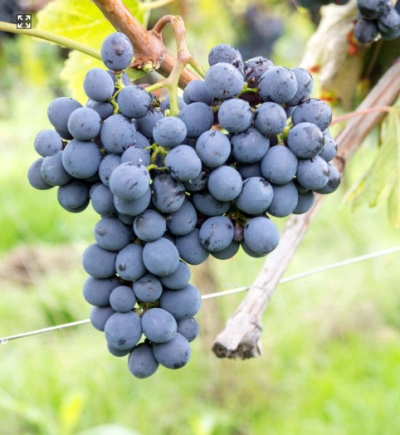
- Authors: Italy
- Appointment: technical
- Berry color: purple
- Taste: varietal
- Ripening period: late
- Name synonyms: Brunello, clone, Calabrese, Cassano, Chiantino, Liliano, Morellino, clone, Negrello, Niellucciolo, Gentile Prugnolo ), Sangiovese Piccolo and others
- Flower type: bisexual
- Density of the bunch: dense
- Skin: covered with gray prune, thin
- Appeared when crossing: Frappato Di Vittoria x Foglia Tonda or Gaglioppo x Foglia Tonda - according to various DNA tests
Sangiovese is the most popular Italian wine grape variety. Sangiovese can be found anywhere in Italy. From this culture, ruby-colored wines are made with spicy aromas of prunes, cherries, cherries and hints of dried herbs. A quality Sangiovese wine is appreciated for its high acidity, confident tannins and natural balance.
Breeding history
There is a constant debate about the origin of this variety. The very name Sangiovese translates as "blood of Jupiter". It is believed that this grape variety has ancient roots, and it was invented by ancient tribes - the Etruscans. The first mention of him is found in the "Treatise on the cultivation of grapes" 1590.
According to various DNA analyzes, there are several hypotheses for the origin of this variety: Frappato Di Vittoria x Folya Tonda or Galloppo x Foglia Tonda.
Moreover, geneticists have discovered the relationship of this grape with several other varieties, for example, with Calabrese Montenuovo.
The Sangiovese variety has many synonyms (clones): Brunello in Montalcino, Prugnolo Gentile in Montepulciano, Morellino in Maremma, Niellucho in Corsica.
Now there are about 14 species of Sangiovese, of which Brunello is considered the most respected.
Geography of distribution
The homeland of this grape is Italy. Most of the crop is harvested in the Tuscany region (about 75% of the total crop). In addition, Sangiovese grapes are grown in America, Australia, Chile, Mexico, New Zealand and Argentina. But it is believed that the original variety is found only in Italy.
Description
Sangiovese is prized for its excellent sour taste. Sangiovese berries have long been used in winemaking. The size of the bushes is medium. This grape grows quickly, but it is considered late to ripen. It grows well on calcified soils and is resistant to many infections.
Ripening period
It is believed that the ripening period of grapes is late. This variety has many subspecies, so ripening times may vary. Moreover, the grapes ripen unevenly. Therefore, the berries must be tasted in order to track the moment of ripening.
Bunches
There are both medium and very large clusters with clearly visible branches. The bunches are dense, their shape is cylindrical-conical or conical.
Berries
The grape has sweet berries of rich black, dark blue or bright purple color. The shade depends on the growing region. Berries are neat, round, medium small in size. The skin of the berries is thin, which causes difficulties in storing and transporting grapes.
Taste
Sweet grapes, knits a little. A refreshing sourness is felt.
Yield
With proper care, yields are achieved at an above average level.


Growing features
The variety requires careful maintenance, depending on weather conditions. This plant needs good light, moderate humidity and warm sun. Dislikes heat and drought.
Landing
It is customary to grow this variety on the illuminated and sunny side of the hill at an altitude of 250 to 350 meters above sea level. It is best to plant this plant in calcined soil. Clay and sandy soils are not good options for growing this variety.
You can plant in early spring when the weather is warm. In good weather conditions, inflorescences begin to appear from mid-April.

Pollination
The flowers of this culture are bisexual. And such flowers have the ability to self-pollinate.
Pruning
When formed at the bush, lifeless shoots and brushes are cut off. In order to speed up the ripening period of the fruit, pinching is performed - the top of the green shoot is cut off. Then the plant directs all the forces to the formation of the vine.



Top dressing
Fertilizers are applied in early spring before flowering, then before the berries ripen and to prepare for the winter season. The plant needs fertilizers containing nitrogen, potassium, phosphorus and other trace elements.
Frost resistance and the need for shelter
Since the homeland of the Sangiovese variety is Italy with a mild climate and sun, this plant is classified as thermophilic. However, you can grow this variety in cooler conditions, only you need to cover it in a timely manner.

Diseases and pests
Sangiovese has an average level of resistance to mildew. This variety is more resistant to powdery mildew and gray rot. To prevent infection, special prevention methods must be used. You can spray this crop from infections and other diseases with special chemicals.
To protect against insects and birds, nets or repelling devices are used.

If a grape is exposed to any disease or insect, this always affects its appearance.
Storage
Sangiovese is stored in oak barrels. After storage, an oak flavor appears even with a tar tinge. After aging in such a barrel, the wine acquires a pleasant aroma of wild raspberries and plums.











































































